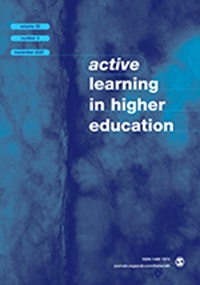Listening to students: Beliefs and attitudes about active learning and effective lecture-style courses
IF 3.8
1区 教育学
Q1 EDUCATION & EDUCATIONAL RESEARCH
引用次数: 0
Abstract
Research shows that active-learning methods (e.g. discussion) are often superior to passive methods (e.g. lecture) with respect to learning outcomes. However, students sometimes report preferring and learning more in lecture-style classes compared to those in which they play an active role. These and related findings suggest students may lack awareness about the relative effectiveness of passive versus active teaching methods on their own learning. Here, we used a mixed methods approach to assess college students’ beliefs, attitudes, and feelings about lecture-style courses ( n = 246). One primary goal was to assess if, and to what extent, students would express an unprompted desire for interaction in lecture-style classes when reflecting, in an open-ended format, upon their real-world educational experiences. Respondents reported that the majority of their classes were lecture style, in accordance with previous research, and noted that they view lecture as a mostly effective form of pedagogy. While respondents described high-level knowledge and compelling delivery of the subject matter, effective class design and use of technology, and good stagecraft on behalf of the instructor as important aspects of effective lecture-style teaching, a substantial proportion of students mentioned interaction as the most important component of an effective lecture style class, suggesting that student preferences for passive classrooms is far from universal. Implications of these findings are discussed.倾听学生的心声:关于主动学习和有效讲授式课程的信念和态度
研究表明,就学习效果而言,主动学习方法(如讨论)往往优于被动学习方法(如讲授)。然而,学生们有时会说,与他们发挥积极作用的课堂相比,他们更喜欢讲授式的课堂,也学得更多。这些发现和相关研究结果表明,学生可能缺乏对被动教学方法和主动教学方法对自身学习效果的相对认识。在此,我们采用混合方法来评估大学生对讲授式课程的信念、态度和感受(n = 246)。其中一个主要目的是评估学生在以开放式形式反思自己的真实教育经历时,是否以及在多大程度上表达了在讲授式课堂上进行互动的愿望。受访者称,与以往的研究结果一致,他们的大部分课堂都是讲授式的,并指出他们认为讲授式教学法是最有效的教学形式。虽然受访者认为高水平的知识和令人信服的主题传达、有效的课堂设计和技术使用以及教师良好的舞台表现是有效讲授式教学的重要方面,但相当一部分学生提到互动是有效讲授式课堂最重要的组成部分,这表明学生对被动课堂的偏好远非普遍现象。本文讨论了这些发现的影响。
本文章由计算机程序翻译,如有差异,请以英文原文为准。
求助全文
约1分钟内获得全文
求助全文
来源期刊

Active Learning in Higher Education
EDUCATION & EDUCATIONAL RESEARCH-
CiteScore
13.20
自引率
12.00%
发文量
31
期刊介绍:
Active Learning in Higher Education is an international, refereed publication for all those who teach and support learning in higher education (HE) and those who undertake or use research into effective learning, teaching and assessment in universities and colleges. The journal is devoted to publishing accounts of research covering all aspects of learning and teaching concerning adults in higher education. Non-discipline specific and non-context/country specific in nature, it comprises accounts of research across all areas of the curriculum; accounts which are relevant to faculty and others involved in learning and teaching in all disciplines, in all countries.
 求助内容:
求助内容: 应助结果提醒方式:
应助结果提醒方式:


